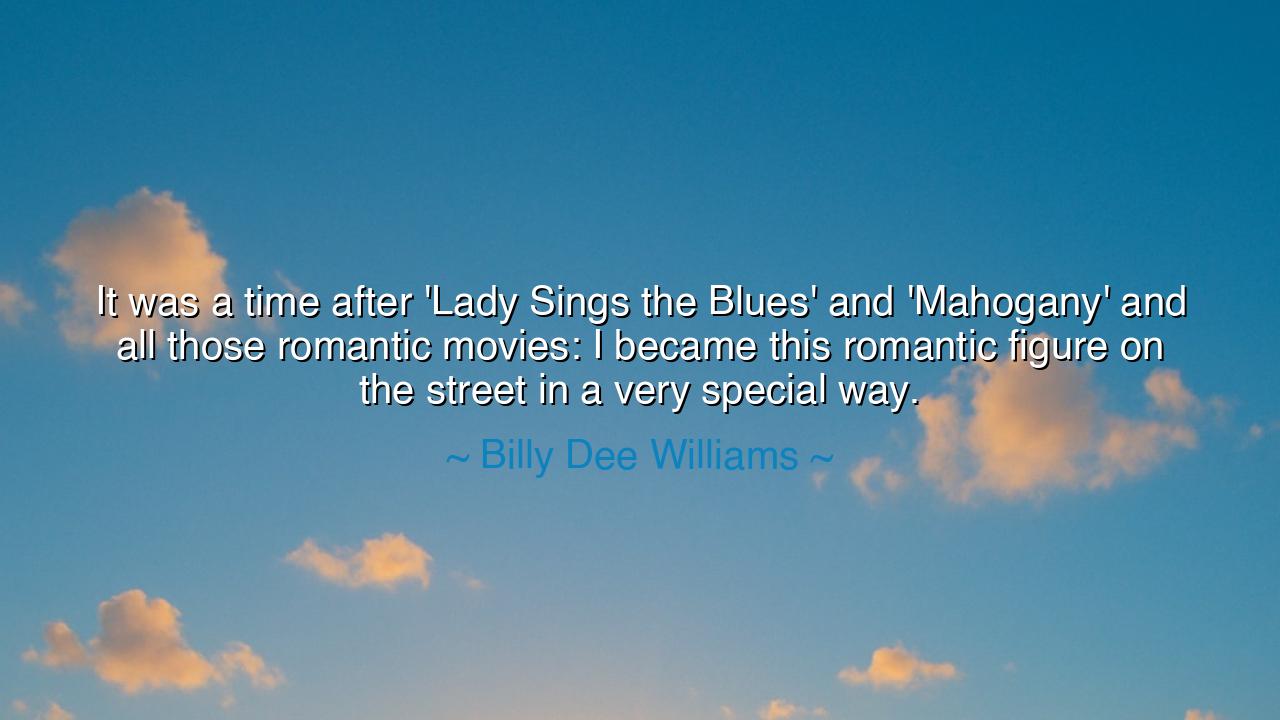
It was a time after 'Lady Sings the Blues' and 'Mahogany' and all
It was a time after 'Lady Sings the Blues' and 'Mahogany' and all those romantic movies: I became this romantic figure on the street in a very special way.






In the words of Billy Dee Williams, spoken with the quiet strength of memory, there lies both a personal truth and a cultural revelation: “It was a time after Lady Sings the Blues and Mahogany and all those romantic movies: I became this romantic figure on the street in a very special way.” These words are more than a recollection of fame—they are a testimony to the power of art, of cinema, and of image to shape how the world perceives a man, and how a man perceives himself.
The ancients knew that the hero of story and stage was not merely an actor, but a vessel of meaning. In Greece, the tragedians clothed mortals in the masks of gods and kings, and those who played such roles carried with them a kind of borrowed power. So it was with Williams. Through his performances in films like Lady Sings the Blues and Mahogany, he became more than an actor—he became an emblem of longing, tenderness, and strength. The audience, swept up in the beauty of those romantic movies, extended their dream onto him, and he emerged not just as a man, but as a romantic figure, alive in the imagination of millions.
To be such a figure is to carry a burden both luminous and heavy. On the one hand, it is an honor to be seen as a symbol of love and elegance, a man whose mere presence evokes poetry and grace. On the other hand, it can feel like an illusion, for behind the romantic figure is a real person with flaws, struggles, and contradictions. Williams, in his honesty, acknowledges both: that the role he played on screen transformed into a role he played in life, as strangers saw him walking the streets not as Billy, but as the living continuation of their cinematic dreams.
History has seen this many times. Consider Rudolph Valentino, the silent film star of the 1920s, who was called the “Latin Lover.” On screen, he embodied desire itself, and in life, women fainted at his public appearances, overcome by the illusion of his romantic aura. Valentino, like Williams, discovered that once the public weaves you into their fantasies, you become a symbol larger than yourself. The roles in films do not end when the credits roll—they spill into the streets, into the hearts of those who watch, and the actor becomes immortal in their eyes.
The deeper meaning of Williams’s words is that art reshapes reality. A film, a song, a performance may begin as entertainment, but when it captures the imagination of a people, it changes how they see the world—and how they see those who embody it. In this way, Williams became not just a performer, but a mirror of dreams. His romantic figure represented hope, elegance, and possibility, especially in an age when representation itself carried great weight for those long denied such images in the mainstream of culture.
The lesson, then, is clear: never underestimate the power of art to create myth. The stories we tell and the roles we play do not vanish into the screen—they linger in the hearts of those who watch, shaping their vision of love, of dignity, of what a man or woman may be. For this reason, the artist carries a responsibility: to honor the symbol they have become, even while living as a mortal with all the complexity of life.
Therefore, O listener, heed this truth: your life, too, is a performance, not upon the grand stages of Hollywood, perhaps, but upon the stage of your community, your family, your world. You may not realize it, but others may see in you a figure of strength, of beauty, of kindness, and they may carry that image with them like a talisman. Live, then, as Williams did, aware that the stories we shape—whether through film or through daily action—can make us romantic figures in the lives of others, symbols of light in a world that longs for meaning.






AAdministratorAdministrator
Welcome, honored guests. Please leave a comment, we will respond soon